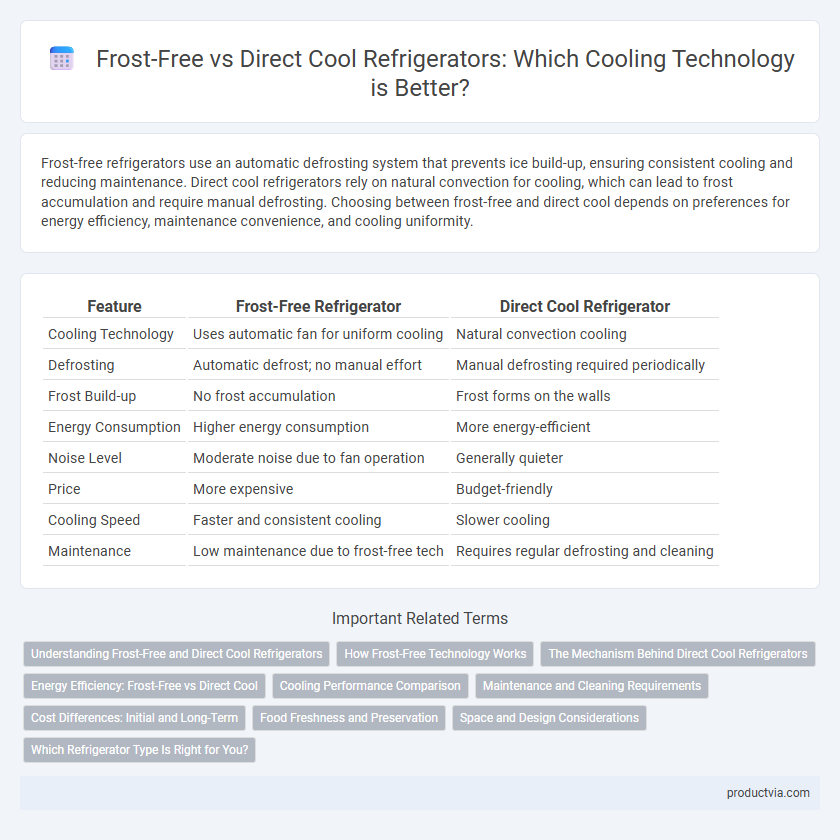Frost-free refrigerators use an automatic defrosting system that prevents ice build-up, ensuring consistent cooling and reducing maintenance. Direct cool refrigerators rely on natural convection for cooling, which can lead to frost accumulation and require manual defrosting. Choosing between frost-free and direct cool depends on preferences for energy efficiency, maintenance convenience, and cooling uniformity.
Table of Comparison
| Feature | Frost-Free Refrigerator | Direct Cool Refrigerator |
|---|---|---|
| Cooling Technology | Uses automatic fan for uniform cooling | Natural convection cooling |
| Defrosting | Automatic defrost; no manual effort | Manual defrosting required periodically |
| Frost Build-up | No frost accumulation | Frost forms on the walls |
| Energy Consumption | Higher energy consumption | More energy-efficient |
| Noise Level | Moderate noise due to fan operation | Generally quieter |
| Price | More expensive | Budget-friendly |
| Cooling Speed | Faster and consistent cooling | Slower cooling |
| Maintenance | Low maintenance due to frost-free tech | Requires regular defrosting and cleaning |
Understanding Frost-Free and Direct Cool Refrigerators
Frost-free refrigerators utilize an automatic defrosting mechanism that prevents ice buildup, ensuring consistent cooling and eliminating the need for manual defrosting. Direct cool refrigerators operate through natural convection, allowing cold air to circulate but often requiring regular manual defrosting to remove frost accumulation. Choosing between these types depends on factors like energy consumption, maintenance convenience, and cooling efficiency.
How Frost-Free Technology Works
Frost-free refrigerators utilize an automatic defrosting mechanism that prevents ice build-up by circulating warm air within the cooling compartment, effectively maintaining consistent temperature and humidity levels. This technology operates through a cycle where a heating element briefly turns on to melt any frost accumulated on the evaporator coils, which then drains out, eliminating the need for manual defrosting. The continuous airflow not only enhances energy efficiency but also preserves food freshness longer by preventing frost-related temperature fluctuations.
The Mechanism Behind Direct Cool Refrigerators
Direct cool refrigerators operate using natural convection, where air circulates inside the refrigerator without any fan assistance, causing uneven cooling and occasional frost buildup on the evaporator coils. The cooling mechanism relies on a static evaporator coil that absorbs heat from the inner compartment, leading to humidity condensation and frost formation over time. Regular manual defrosting is necessary to maintain efficiency, distinguishing direct cool units from frost-free models that use fans and automatic defrost cycles.
Energy Efficiency: Frost-Free vs Direct Cool
Frost-free refrigerators use a built-in fan to circulate air and prevent ice build-up, resulting in higher energy consumption compared to direct cool models that rely on natural convection and need manual defrosting. Direct cool refrigerators consume less power due to their simpler cooling mechanism, making them more energy-efficient and cost-effective for households prioritizing lower electricity bills. However, frost-free refrigerators offer convenience and consistent cooling, balancing energy use with maintenance needs.
Cooling Performance Comparison
Frost-Free refrigerators utilize automatic defrosting mechanisms that maintain consistent cooling by preventing ice buildup, resulting in uniform temperature distribution and enhanced food preservation. Direct Cool models rely on natural convection to cool, which may cause uneven temperature zones and require manual defrosting, potentially affecting overall cooling efficiency. Frost-Free technology typically delivers superior cooling performance, especially in maintaining stable temperatures and reducing maintenance for optimal refrigeration.
Maintenance and Cleaning Requirements
Frost-free refrigerators require less frequent manual defrosting and cleaning due to their automatic defrost system, which prevents ice buildup and reduces maintenance time. Direct cool refrigerators, on the other hand, need regular defrosting to remove ice accumulation, increasing cleaning efforts and maintenance frequency. Choosing frost-free models offers better convenience for users seeking lower upkeep and consistent cooling performance.
Cost Differences: Initial and Long-Term
Frost-free refrigerators typically have a higher initial cost due to advanced cooling technology and built-in fans that prevent ice build-up, while direct cool models are more budget-friendly with simpler designs. Long-term expenses favor frost-free units because they eliminate manual defrosting, saving time and reducing energy consumption as the system maintains consistent temperatures. However, direct cool refrigerators usually consume less electricity during operation, resulting in slightly lower energy bills despite the need for periodic defrosting.
Food Freshness and Preservation
Frost-Free refrigerators maintain consistent temperatures through automatic defrost cycles, minimizing ice buildup and enhancing food freshness by preventing freezer burn and moisture loss. Direct Cool refrigerators rely on natural convection, which can cause uneven cooling and frost accumulation, potentially compromising food preservation and reducing shelf life. Selecting a Frost-Free model improves long-term freshness by ensuring stable humidity and temperature levels essential for optimal food storage.
Space and Design Considerations
Frost-free refrigerators typically have bulkier interiors and require additional components like fans and heaters, which can reduce usable storage space compared to direct cool models that offer more straightforward, compact designs. Direct cool refrigerators often feature simpler construction, making them lighter and suitable for smaller kitchens or limited spaces where ease of installation and maintenance are priorities. When selecting between frost-free and direct cool options, evaluating the available kitchen space and desired storage capacity helps determine the best fit for design and functionality.
Which Refrigerator Type Is Right for You?
Frost-free refrigerators use an automatic defrosting system that prevents ice build-up, offering low maintenance and consistent cooling ideal for busy households. Direct cool refrigerators rely on natural convection for cooling and require manual defrosting, making them energy-efficient and budget-friendly for smaller spaces or single users. Choosing between frost-free and direct cool depends on preferences for convenience, energy consumption, and usage frequency.
Frost-Free vs Direct Cool for Refrigeration Infographic

 productvia.com
productvia.com